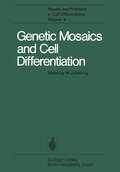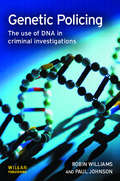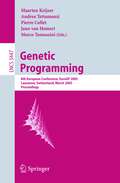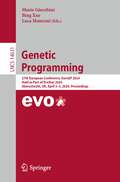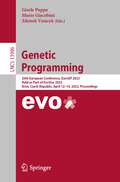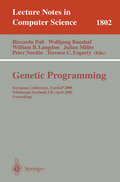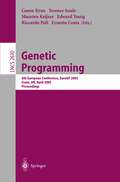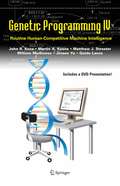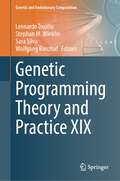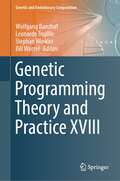- Table View
- List View
Genetic Methods and Tools for Managing Crop Pests
by A. K. ChakravarthyThis contributed volume aims at bringing together all the genetic engineering tools for managing various types of crop pests. The main focus of this book is to explore the application of these tools in pest management. Major pest groups covered in this book are insects, mites and nematodes.The first section covers all major genetic tools and molecular approaches. The second section deals with genetic tools for of beneficial containing three chapters involving honey bees, silkworms and natural enemies. Next section deals with genetic interactions against pests in diverse geographical regions with special focus on Africa, Vietnam and Sri Lanka. Sections four and five addresses diverse aspects as management of pests, genetic behavior, gene expression, plasticity, pathways and interactions and options for mitigation of pests.It serves as a useful resource for professionals in the fields of entomology, agronomy, horticulture, ecology, and environmental sciences, as well as to agricultural producers and plant biotechnologists.
Genetic Modification of Hematopoietic Stem Cells: Methods and Protocols (Methods in Molecular Biology #506)
by Christopher BaumGene Transfer into Hematopoietic Cells: From Basic Science to Clinical Application Christopher Baum 1. The Potential of Gene Transfer into Hematopoietic Vectors with the potential for stable transgene integration are Cells widely used in basic hematology and clinical trials of gene me- cine. In basic research, both gain-of-function and loss-of-fu- tion situations of individual genes can be created by gene transfer, leading to a wide range of applications in developmental biology, stem cell biology, immunology, leukemia research, and human genetics. With the first evidence of successful modification of murine hematopoietic cells using retroviral gene vectors (1, 2), researchers have also explored the therapeutic potential of this approach. To date, the emerging discipline of gene therapy is a highly diversified field that offers entirely novel approaches to treat a great variety of human diseases (3). All hematopoietic cell types are of major interest in this context, since the modification of the hematopoietic stem cell population may potentially give rise to a completely transgenic hematopoiesis with the potential to cure genetic disorders or fight severe chronic infections, and the targeting of mature cells such as lymphocytes or antigen-p- senting dendritic cells offers all types of transient and semiper- nent modifications of the immune system. The unifying principle of gene medicine is the need to transfer complex nucleic acids cells that do not contribute to the germline (somatic cells).
Genetic Modification of Plants: Agriculture, Horticulture and Forestry (Biotechnology in Agriculture and Forestry #64)
by Frank Kempken Christian JungConceived with the aim of sorting fact from fiction over genetically modified (GM) crops, this book brings together the knowledge of 30 specialists in the field of transgenic plants. It covers the generation and detection of these plants as well as the genetic traits conferred on transgenic plants. In addition, the book looks at a wide variety of crops, ornamental plants and tree species that are subject to genetic modifications, assessing the risks involved in genetic modification as well as the potential economic benefits of the technology in specific cases. The book’s structure, with fully cross-referenced chapters, gives readers a quick access to specific topics, whether that is comprehensive data on particular species of ornamentals, or coverage of the socioeconomic implications of GM technology. With an increasing demand for bioenergy, and the necessary higher yields relying on wider genetic variation, this book supplies all the technical details required to move forward to a new era in agriculture.
Genetic Mosaics and Cell Differentiation (Results and Problems in Cell Differentiation #9)
by W. J. GehringThe relationship of cell lineage and differentiation is one of the most intriguing problems in developmental biology. In most higher organisms, the analysis of the cell lineage has to rely on indirect methods. Only in the most suitable systems, like the nematodes, can the pattern of cell division be determined by direct observation under the microscope. In cases where this is not possible, the fate of the cells has to be examined by using cell markers. Most suitable for this purpose are genetic markers, provided that they do not interfere with the developmental pathway to be studied. However, suitable genetic markers and techniques for generating genetic mosaics are available in a few organisms only. Therefore, this volume is largely concerned with Drosophila and the mouse, which have been studied most extensively. In 1929 STURTEVANT introduced the analysis of gynandromorphs into devel opmental genetics. However, this important contribution remained largely unnoticed until the late sixties, when the potential of this technique for deter mining embryonic fate maps and the number of primordial cells was exploited, and the methodology extended to the mapping of mutational foci. Mitotic recombination was demostrated by STER:-< in 1936, who realized the potential of this technique for the analysis of cell lineage and pattern formation. The usefulness of this method was substantially increased by the discovery of FRIESEN that mitotic recombination can be induced by x-irradiation. This allows the induction of mosaicism at any stage of development.
Genetic Policing: The Uses of DNA in Police Investigations
by Robin Williams Paul JohnsonThis book is about the increasing significance of DNA profiling for crime investigation in modern society. It focuses on developments in the UK as the world-leader in the development and application of forensic DNA technology and in the construction of DNA databases as an essential element in the successful use of DNA for forensic purposes. The book uses data collected during the course of Wellcome Trust funded research into police uses of the UK National DNA Database (NDNAD) to describe the relationship between scientific knowledge and police investigations. It is illustrated throughout by reference to some of the major UK criminal cases in which DNA evidence has been presented and contested.
Genetic Polymorphism and cancer susceptibility
by Aga Syed Sameer Mujeeb Zafar Banday Saniya NissarThis book discusses the role of genetic polymorphism in susceptibility to cancers. The book explores the understanding of differences between the genetic polymorphisms and mutations.It reviews the mechanisms underlying the effect of polymorphism in genes encoding proteins that play an essential role in metabolism, signal transduction, cell cycle, and DNA repair mechanisms. Further, it investigates various techniques that are used for analyzing the genetic polymorphisms. The book contains many chapters which summarize the importance of genetic information obtained from polymorphism-based pharmaco-genetic tests to predict better drug response and life-threatening adverse reactions to chemotherapeutic agents, help in understanding of the impact of SNPs on gene function, and gives overview of the different SNP databases for examination. This book, therefore, serves as an essential guidebook for independent researchers as well as institutions working in this specialised field.
Genetic Polymorphism and Disease
by Syed Sameer Aga Mujeeb Zafar Banday Saniya NissarGenetic polymorphisms are important determinants of phenotypic variations and may modulate the risk to or even cause various diseases including genetic disorders and multifactorial diseases. Genetic polymorphisms also serve as important genetic, population and evolutionary markers that allow the study of genetic and evolutionary aspects of individuals, populations and organisms and aid in tracing the evolutionary and parental lineages. Genetic polymorphisms in low penetrance genes are responsible for the alterations in the gene expression of critical signal transduction proteins and metabolic enzymes. Some of these polymorphisms are linked to increased susceptibility to various diseases especially cancers, cardiovascular diseases, immune disorders, neurological pathologies. This book collates the reviews on the roles played by polymorphisms in critical metabolic, signal transduction, cell cycle or DNA repair genes either directly or indirectly in the disease mechanisms. The focus is on various techniques for identifying the various Single Nucleotide Polymorphisms (SNPs). Polymorphism studies document the affect SNPs, and their expressions have upon the functionality of the enzymes, proteins. Key Features Describes the genetic polymorphism and its various types Discusses the role of genetic polymorphisms in modulating the risk of various human diseases Explores various molecular techniques used for detecting GPs Characterizes the role of SNPs in modulating the susceptibility of human diseases Provides a genetic basis for individual variations in response to therapeutics
Genetic Polymorphism and Disease
by Syed Sameer Aga Mujeeb Zafar Banday Saniya NissarGenetic polymorphisms are important determinants of phenotypic variations and may modulate the risk to or even cause various diseases including genetic disorders and multifactorial diseases. Genetic polymorphisms also serve as important genetic, population and evolutionary markers that allow the study of genetic and evolutionary aspects of individuals, populations and organisms and aid in tracing the evolutionary and parental lineages. Genetic polymorphisms in low penetrance genes are responsible for the alterations in the gene expression of critical signal transduction proteins and metabolic enzymes. Some of these polymorphisms are linked to increased susceptibility to various diseases especially cancers, cardiovascular diseases, immune disorders, neurological pathologies. This book collates the reviews on the roles played by polymorphisms in critical metabolic, signal transduction, cell cycle or DNA repair genes either directly or indirectly in the disease mechanisms. The focus is on various techniques for identifying the various Single Nucleotide Polymorphisms (SNPs). Polymorphism studies document the affect SNPs, and their expressions have upon the functionality of the enzymes, proteins. Key Features Describes the genetic polymorphism and its various types Discusses the role of genetic polymorphisms in modulating the risk of various human diseases Explores various molecular techniques used for detecting GPs Characterizes the role of SNPs in modulating the susceptibility of human diseases Provides a genetic basis for individual variations in response to therapeutics
Genetic Preservation of Plant Cells in Vitro (Springer Lab Manuals)
by Brian GroutThe long-term storage and maintenance of viable plant cells and organs is an area of active concern across the range of pure and applied plant sciences. In academic, government and commercial laboratories, the extended storage of propagules of one sort or another, with maximum protection of the genome from mutation and altered expression, is often a very necessary activity that can draw heavily on resources and effort. However, preservation per se is typically not an activity in its own right, but a facilitating technology that is part of a larger programme of work. Consequently, there are many laboratories that do not have the benefit of a specialist in storage technology, and have to delegate the responsibility to individuals, or teams, who are faced with a daunting learning curve. To maximise the chances of success, in the shortest possible time and with minimum losses, these researchers need sources of reference that are au thoritative and soundly based in practical experience.
Genetic Programming: 8th European Conference, EuroGP 2005, Lausanne, Switzerland, March 30-April 1, 2005, Proceedings (Lecture Notes in Computer Science #3447)
by Pierre Collet Jano Van Hemert Marco Tomassini Maarten Keijzer Andrea TettamanziIn this volume we present the contributions for the 18th European Conference on Genetic Programming (EuroGP 2005). The conference took place from 30 March to 1 April in Lausanne, Switzerland. EuroGP is a well-established conf- ence and the only one exclusively devoted to genetic programming. All previous proceedings were published by Springer in the LNCS series. From the outset, EuroGP has been co-located with the EvoWorkshops focusing on applications of evolutionary computation. Since 2004, EvoCOP, the conference on evolutionary combinatorial optimization, has also been co-located with EuroGP, making this year’s combined events one of the largest dedicated to evolutionary computation in Europe. Genetic programming (GP) is evolutionary computation that solves complex problems or tasks by evolving and adapting a population of computer programs, using Darwinian evolution and Mendelian genetics as its sources of inspiration. Some of the 34 papers included in these proceedings address foundational and theoretical issues and there is also a wide variety of papers dealing with di?erent application areas, such as computer science, engineering, language processing, biology and computational design, demonstrating that GP is a powerful and practical problem-solving paradigm.
Genetic Programming: 27th European Conference, EuroGP 2024, Held as Part of EvoStar 2024, Aberystwyth, UK, April 3–5, 2024, Proceedings (Lecture Notes in Computer Science #14631)
by Mario Giacobini Bing Xue Luca ManzoniThis book constitutes the refereed proceedings of the 27th European Conference on Genetic Programming, EuroGP 2024, held in Aberystwyth, UK, April 3–5, 2024 and co-located with the EvoStar events, EvoCOP, EvoMUSART, and EvoApplications.The 13 papers (9 selected for long presentation and 4 for short presentation) collected in this book were carefully reviewed and selected from 24 submissions. The wide range of topics in this volume reflects the current state of research in the field. The collection of papers cover topics including developing new variants of GP algorithms, as well as exploring GP applications to the optimization of machine learning methods and the evolution of control policies.
Genetic Programming: 26th European Conference, EuroGP 2023, Held as Part of EvoStar 2023, Brno, Czech Republic, April 12–14, 2023, Proceedings (Lecture Notes in Computer Science #13986)
by Gisele Pappa Mario Giacobini Zdenek VasicekThis book constitutes the refereed proceedings of the 26th European Conference on Genetic Programming, EuroGP 2023, held as part of EvoStar 2023, in Brno, Czech Republic, during April 12–14, 2023, and co-located with the EvoStar events, EvoCOP, EvoMUSART, and EvoApplications. The 14 revised full papers and 8 short papers presented in this book were carefully reviewed and selected from 38 submissions. The wide range of topics in this volume reflects the current state of research in the field. The collection of papers cover topics including developing new variants of GP algorithms for both optimization and machine learning problems as well as exploring GP to address complex real-world problems.
Genetic Programming: European Conference, EuroGP 2000 Edinburgh, Scotland, UK, April 15-16, 2000 Proceedings (Lecture Notes in Computer Science #1802)
by Riccardo Poli Wolfgang Banzhaf William B. Langdon Julian F. Miller Peter Nordin Terence C. FogartyThis volume contains the proceedings of EuroGP 2000, the European Conf- ence on Genetic Programming, held in Edinburgh on the 15th and 16th April 2000. This event was the third in a series which started with the two European workshops: EuroGP’98, held in Paris in April 1998, and EuroGP’99, held in Gothenburg in May 1999. EuroGP 2000 was held in conjunction with EvoWo- shops 2000 (17th April) and ICES 2000 (17th-19th April). Genetic Programming (GP) is a growing branch of Evolutionary Compu- tion in which the structures in the population being evolved are computer p- grams. GP has been applied successfully to a large number of di?cult problems like automatic design, pattern recognition, robotic control, synthesis of neural networks, symbolic regression, music and picture generation, biomedical app- cations, etc. In recent years,even human-competitive results have been achieved by a number of groups. EuroGP 2000, the ?rst evolutionary computation conference of the new m- lennium, was the biggest event devoted to genetic programming to be held in Europe in 2000. It was a high quality conference where state-of-the-art work on the theory of GP and applications of GP to real world problems was presented.
Genetic Programming: 6th European Conference, EuroGP 2003, Essex, UK, April 14-16, 2003. Proceedings (Lecture Notes in Computer Science #2610)
by Conor Ryan Terence Soule Riccardo Poli Edward Tsang Maarten Keijzer Ernesto CostaIn this volume we present the accepted contributions to the Sixth European Conference on Genetic Programming (EuroGP 2003) which took place at the University of Essex, UK on 14-16 April 2003. EuroGP is now a well-established conference and, without any doubt, the most important international event - voted to Genetic Programming occurring in Europe. The proceedings have all been published by Springer-Verlag in the LNCS series. EuroGP began as an - ternational workshop in Paris, France in 1998 (14–15 April, LNCS 1391). Sub- quently the workshop was held in G¨ oteborg, Sweden in 1999 (26–27 May, LNCS 1598) and then EuroGP became an annual conference: in 2000 in Edinburgh, UK (15–16 April, LNCS 1802), in 2001 in Lake Como, Italy (18–19 April, LNCS 2038) and in 2002 in Kinsale, Ireland (3–5 April, LNCS 2278). From the outset, there have always been specialized workshops, co-located with EuroGP, focusing on applications of evolutionary algorithms (LNCS 1468, 1596, 1803, 2037, and 2279). This year was no exception and EvoWorkshops 2003, incorporating Evo- BIO, EvoCOP, EvoIASP, EvoMUSART, EvoSTIM and EvoROB, took place at the University of Essex (LNCS 2611). Genetic Programming (GP) is that part of Evolutionary Computation which solves particular complex problems or tasks by evolving and adapting popu- tions of computer programs, using Darwinian evolution and Mendelian genetics as a source of inspiration.
Genetic Programming IV: Routine Human-Competitive Machine Intelligence (Genetic Programming #5)
by John R. Koza Martin A. Keane Matthew J. Streeter William Mydlowec Jessen Yu Guido LanzaGenetic Programming IV: Routine Human-Competitive Machine Intelligence presents the application of GP to a wide variety of problems involving automated synthesis of controllers, circuits, antennas, genetic networks, and metabolic pathways. The book describes fifteen instances where GP has created an entity that either infringes or duplicates the functionality of a previously patented 20th-century invention, six instances where it has done the same with respect to post-2000 patented inventions, two instances where GP has created a patentable new invention, and thirteen other human-competitive results. The book additionally establishes: GP now delivers routine human-competitive machine intelligence GP is an automated invention machine GP can create general solutions to problems in the form of parameterized topologies GP has delivered qualitatively more substantial results in synchrony with the relentless iteration of Moore's Law
Genetic Programming Theory and Practice XIX (Genetic and Evolutionary Computation)
by Leonardo Trujillo Stephan M. Winkler Sara Silva Wolfgang BanzhafThis book brings together some of the most impactful researchers in the field of Genetic Programming (GP), each one working on unique and interesting intersections of theoretical development and practical applications of this evolutionary-based machine learning paradigm. Topics of particular interest for this year´s book include powerful modeling techniques through GP-based symbolic regression, novel selection mechanisms that help guide the evolutionary process, modular approaches to GP, and applications in cybersecurity, biomedicine and program synthesis, as well as papers by practitioner of GP that focus on usability and real-world results. In summary, readers will get a glimpse of the current state of the art in GP research.
Genetic Programming Theory and Practice XVIII (Genetic and Evolutionary Computation)
by Leonardo Trujillo Wolfgang Banzhaf Bill Worzel Stephan WinklerThis book, written by the foremost international researchers and practitioners of genetic programming (GP), explores the synergy between theoretical and empirical results on real-world problems, producing a comprehensive view of the state of the art in GP. In this year’s edition, the topics covered include many of the most important issues and research questions in the field, such as opportune application domains for GP-based methods, game playing and co-evolutionary search, symbolic regression and efficient learning strategies, encodings and representations for GP, schema theorems, and new selection mechanisms. The book includes several chapters on best practices and lessons learned from hands-on experience. Readers will discover large-scale, real-world applications of GP to a variety of problem domains via in-depth presentations of the latest and most significant results.
Genetic Recombination: Reviews and Protocols (Methods in Molecular Biology #262)
by Alan S. WaldmanGenetic recombination, in the broadest sense, can be defined as any process in which DNA sequences interact and undergo a transfer of information, producing new “recombinant” sequences that contain information from each of the original molecules. All organisms have the ability to carry out recombination, and this striking universality speaks to the essential role recombination plays in a variety of biological processes fundamentally important to the maintenance of life. Such processes include DNA repair, regulation of gene expression, disease etiology, meiotic chromosome segregation, and evolution. One important aspect of recombination is that it typically occurs only between sequences that display a high degree of sequence identity. The stringent requirement for homology helps to ensure that, under normal circumstances, a cell is protected from deleterious rearrangements since a swap of genetic information between two nearly identical sequences is not expected to dramatically alter a genome. Recombination between dissimilar sequences, which does happen on occasion, may have such harmful consequences as chromosomal translocations, deletions, or inversions. For many organisms, it is also important that recombination rates are not too high lest the genome become destabilized. Curiously, certain organisms, such as the trypanosome parasite, actually use a high rate of recombination at a particular locus in order to switch antigen expression continually and evade the host immune system effectively.
Genetic Reconstruction of the Past: DNA Analysis in Forensics and Human Evolution
by Henry A. ErlichThe same DNA technology that allows the analysis of a hair or tiny blood spot at a crime scene also enables sequencing the DNA of a bone fragment from a Neanderthal skeleton. Comparing the DNA sequences of different samples and comparing the frequency of specific genetic variants in different populations is a critical part of both forensic and evolutionary investigations. These two fields share a common goal: solving historical mysteries. The book discusses the intrinsic human curiosity about our origins and the desire to solve crimes and seek justice and how the recent emergence of DNA analysis has transformed our ability to address these universal human aspirations. The unifying theme of the book is the recently developed capacity to use DNA sequence information to make inferences about historical events. Part One is a discussion of how DNA analysis can reconstruct the recent past, in particular, the events that transpired at the scene of a crime. Part Two is a discussion of the application of DNA analysis to reconstructing the ancient past, using DNA sequences from human samples as well as from fossil remains to study the evolution of the human species and the historical relationships among contemporary and extinct human populations. Erlich discuss how he, along with his colleagues at Cetus Corp in the mid-1980s developed the PCR (polymerase chain reaction) technology of specific DNA amplification, a method of synthesizing millions of copies of a specific targeted DNA sequence and applied it to address forensic and evolutionary questions. It is this capacity, that has transformed both forensic science and evolutionary biology and has led to both the identification-and exoneration-of criminal suspects and a deeper understanding of human evolution. These techniques, now widely used, were applied in the first DNA criminal case, the first exoneration case, and the first identification of a missing person. Discussions on the history and the many remaining contentious issues in forensic DNA analysis in Part One are organized around several specific criminal cases, while the book tries to convey the spirit of "doing science."
Genetic Reconstruction of the Past: DNA Analysis in Forensics and Human Evolution
by Henry A. ErlichThe same DNA technology that allows the analysis of a hair or tiny blood spot at a crime scene also enables sequencing the DNA of a bone fragment from a Neanderthal skeleton. Comparing the DNA sequences of different samples and comparing the frequency of specific genetic variants in different populations is a critical part of both forensic and evolutionary investigations. These two fields share a common goal: solving historical mysteries. The book discusses the intrinsic human curiosity about our origins and the desire to solve crimes and seek justice and how the recent emergence of DNA analysis has transformed our ability to address these universal human aspirations. The unifying theme of the book is the recently developed capacity to use DNA sequence information to make inferences about historical events. Part One is a discussion of how DNA analysis can reconstruct the recent past, in particular, the events that transpired at the scene of a crime. Part Two is a discussion of the application of DNA analysis to reconstructing the ancient past, using DNA sequences from human samples as well as from fossil remains to study the evolution of the human species and the historical relationships among contemporary and extinct human populations. Erlich discuss how he, along with his colleagues at Cetus Corp in the mid-1980s developed the PCR (polymerase chain reaction) technology of specific DNA amplification, a method of synthesizing millions of copies of a specific targeted DNA sequence and applied it to address forensic and evolutionary questions. It is this capacity, that has transformed both forensic science and evolutionary biology and has led to both the identification-and exoneration-of criminal suspects and a deeper understanding of human evolution. These techniques, now widely used, were applied in the first DNA criminal case, the first exoneration case, and the first identification of a missing person. Discussions on the history and the many remaining contentious issues in forensic DNA analysis in Part One are organized around several specific criminal cases, while the book tries to convey the spirit of "doing science."
Genetic Resources and Their Exploitation — Chickpeas, Faba beans and Lentils (Advances in Agricultural Biotechnology #6)
by J. R. Witcombe W. ErskineChickpeas, faba beans and lentils are important pulse crops in the Mediterranean regi on and Mi ddl e East, where thei r hi gh protei n seed nutritionally complement cereal grain in the human diet. The by-products of these crops serve as a valuable feed for animals. Thanks to their ability to fix atmospheric nitrogen, the inclusion of these crops in the cropping system helps in the maintenance of the productivity of the soil and reduces the dependence of the farmer on fertilizer nitrogen to realise good yields. Being the site of original domestication of these legumes, the Fertile Crescent is bel ieved to possess their vast genetic diversity. In order to prevent the erosion of this genetic di'/ersity and to preserve it for posterity, it is necessary that a major effort is made for its expeditious collection, evaluation, documentation and safe storage. The International Center for Agricultural Research in the Dry Areas (ICARDA) being located in the Fertile Crescent has, within its mandate, the responsibility to act as a world centre for the work on the genetic resources of kabuli chickpeas, faba beans and lentils. The International Board of Plant Genetic Resources (IBPGR) has been strongly supporting ICARDA in this important activity.
Genetic Resources, Chromosome Engineering, and Crop Improvement: Medicinal Plants, Volume 6
by Ram J. SinghMedicinal Plants, Volume 6 of the Genetic Resources, Chromosome Engineering, and Crop Improvement series summarizes landmark research and describes medicinal plants as nature's pharmacy. HighlightsExamines the use of molecular technology for maintaining authenticity and quality of plant-based productsDetails reports on individual medicinal plants i
Genetic Resources, Chromosome Engineering, and Crop Improvement: Forage Crops, Vol 5
by Ram J. SinghIn recent decades, livestock producers have moved away from open grazing for a number of reasons, none having to do with the health of consumers. Genetic Resources, Chromosome Engineering, and Crop Improvement: Forage Crops demonstrates how state-of-the-art technology can encourage the raising of livestock in open pastures where they can be fed gra
Genetic Resources, Chromosome Engineering, and Crop Improvement: Vegetable Crops, Volume 3
by Ram J. SinghSummarizing landmark research, Volume 3 of this essential series furnishes information on the availability of germplasm resources that breeders can exploit for producing high-yielding vegetable crop varieties. Written by leading international experts, this volume offers the most comprehensive and up-to-date information on employing genetic resource
Genetic Resources, Chromosome Engineering, and Crop Improvement: Oilseed Crops, Volume 4
by Ram J. SinghSummarizing landmark research, Volume 4 of this essential seriesfurnishes information on the availability of germplasm resources that breeders can exploit for producing high-yielding oilseed crop varieties. Written by leading international experts, this volume presents the most up-to-date information on employing genetic resources to increas



